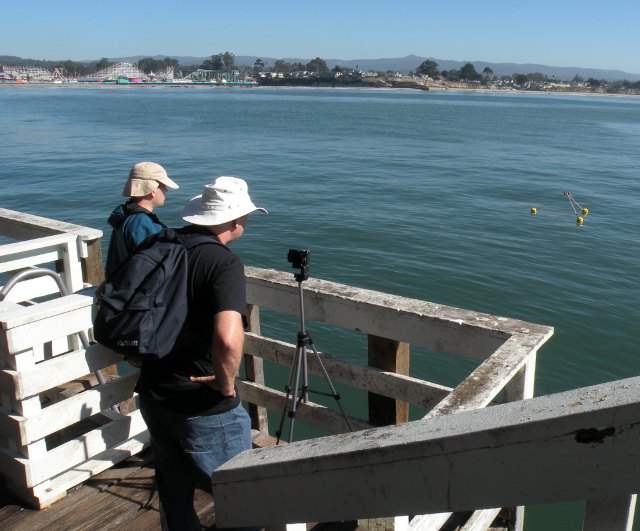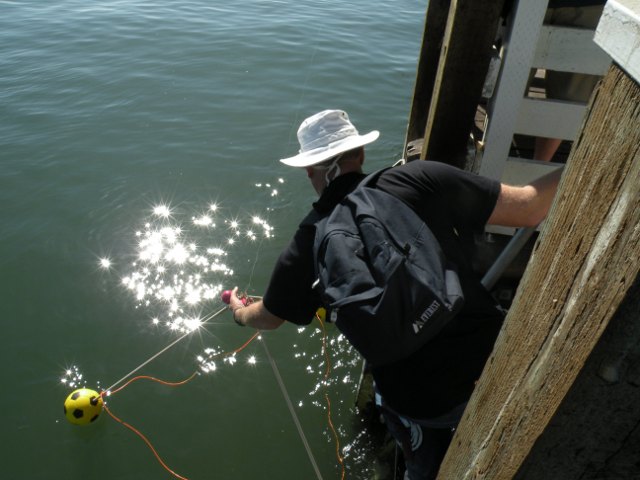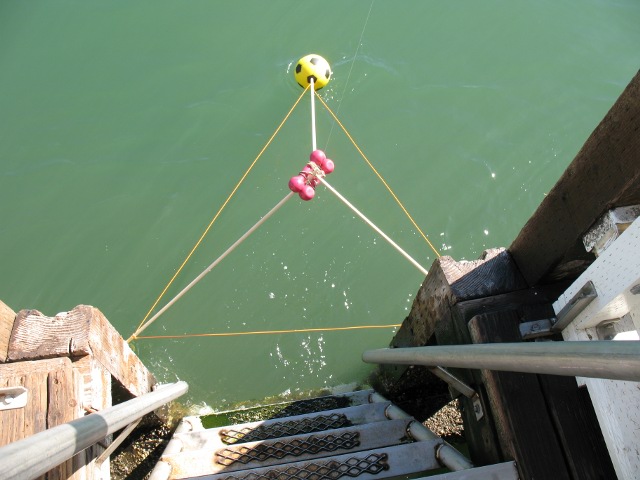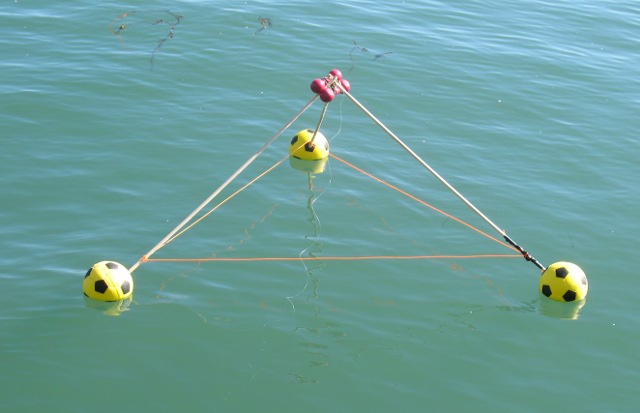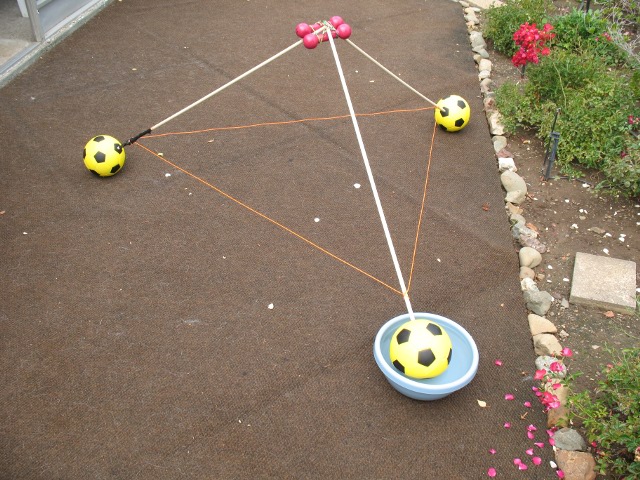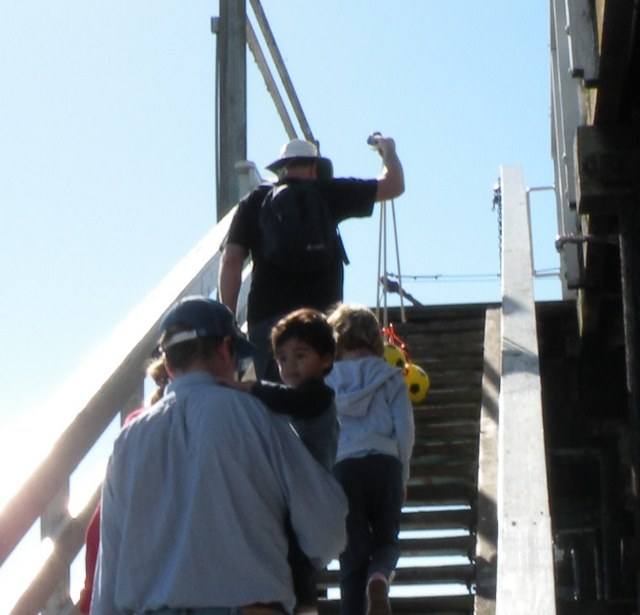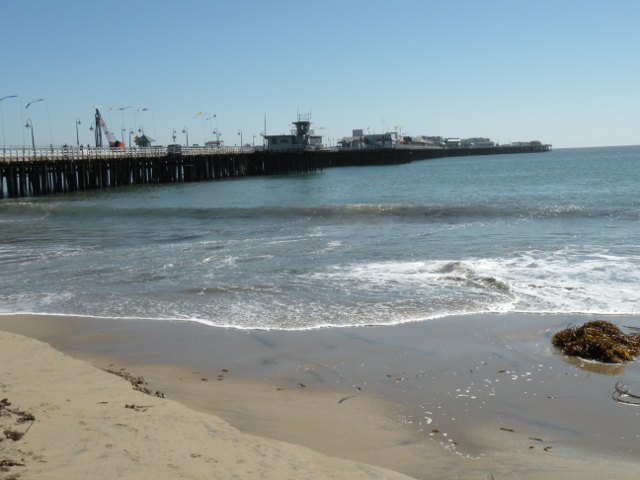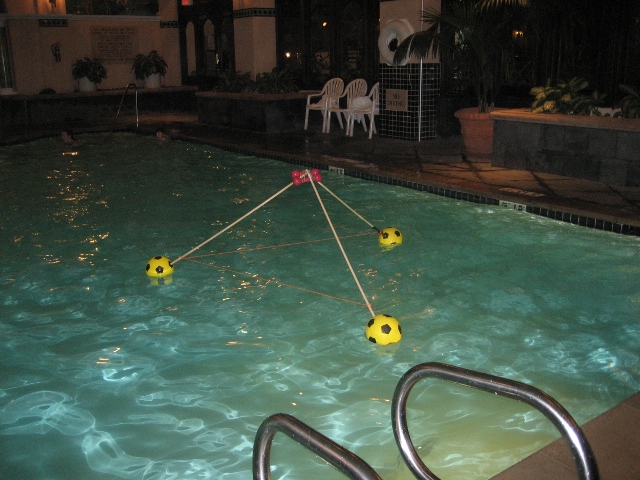Difference between revisions of "User:Vincecate/WaterWalker"
(→More Pictures) |
(→Future Model tests) |
||
| Line 97: | Line 97: | ||
Might get longer dowels. | Might get longer dowels. | ||
| + | |||
| + | Probably will try replacing the balls with PCV pipes tied to the dowels. So the tripod would be partly underwater. The PVC pipes could move some with the waves, a bit like the MultiSpar. This would give us a smaller waterline area and so waves should not move it as quickly. Would also use a large rope around the base of the tripod to reduce heave. Probably do this by the end of November. I think this will be the most stable seastead model so far. | ||
==Prototype designs == | ==Prototype designs == | ||
Revision as of 05:44, 20 October 2008
Contents
Description
The idea is to have a very wide base, like 150 feet, so that you do not tip much in the waves. This is basically a tripod with balls for floats on each of the 3 legs. There is also a string to keep the legs from moving out further. The living area would be below where the weights are in the model in the center.
Detail
- Material issues - plastic for the balls, aluminum, steel, or wood for the compression members. These might be truss or pipe shapes.
- Tension members could be plastic rope or steel cable
- Would use kite and sea anchor for movement on migration
Energy Generation and Storage
If we had 6 legs instead of 3 as in the model and let the legs flex up and down, we could use that motion to drive pumps that pumped air into the balls. Then we could run a propeller or generator from the compressed air.
Requirements Analysis
- Safety
- It is very wide compared to boats and so should be very stable
- No active ballast controls so no chance of that going wrong
- Comfort
- Should have a gentle motion on normal days but significant response to large waves.
- Cost
- This should be one of the cheapest designs. It's very simple. Although it is as wide as a large cruise ship, most of the area is just cables over open space.
- Pretty
- Looks nice. Could have walkways going down to each of the 3 balls and a platform and big umbrella on each. Could be very pretty.
- Modular
- Can make individual family sized units. Could have cable under a line of these so they floated together if you connected a sea anchor at one end and a large kite at the other.
- Cargo
- Since it floats up and down with waves like a boat, should be reasonable to dock a boat next to it. Probably have a small dock mounted on the wall so it could float up and down a bit relative to the wall. Need a walkway from house to where boat will dock.
- Free Floating
- Yes, could anchor also.
- Scalable
- Scales up or down in size (height, diameter).
- Standards
- Mobile
- Could be made to fold up with balls detaching or come apart with each leg and ball as a separate unit. Then it
could be transported by truck or barge easily.
- Draft
- Very shallow draft.
Video of 6-foot model
The model is 1:25 scale. In the model the 1/2 inch wood dowels are 4 feet long, so would be 100 feet in a full scale model. From the edge of one ball to another is about 6 feet. The tests below are with 6 lbs. Note that each 1 lb in the model is over 15,000 lbs in full scale.
The balls are a bit over 6 inches, so over 12.5 feet in full scale. In the videos below the wind driven waves are around 6 inches, so around 12.5 feet in full scale. There is also a swell from far away which can go up and down a couple feet.
These videos are slowed by 4 but should really be slowed by 5 since 1:25 scale.
<youtube v="RWY7mcRwg8g" />
From down on the side of the pier.
<youtube v="7sEPFt8JS7Y" />
Also from the side of the pier.
<youtube v="YNbmb0vLN9g" />
Shot from the top of the pier at the end of the pier.
Aquaculture
You could have a net under the whole structure, attached to the 3 corners, to make a place for aquaculture. Fresh water fish farms use automatic feeders where the fish bump something and then get a piece of food. With these no food is wasted. Don't know if salt water farms use these but I expect they could.
One possible problem is that moving through the water would be harder with a big net underwater.
Model Cost
It was $20 for the 3 foam soccer balls and $15 for the sticks, string, and keyring (at OSH). So total cost was about $35.
Model Design Wins
This model was the only model at the 1st Seasteading conference (2008) that could hold over 1 lb. So it won the model stability challenge and the low cost challenge.
Future Model tests
I could have made the strings longer so the legs were further apart and the center lower. This would have made it even more stable. Only downside is a bit more compression on the sticks, but probably fine.
I could have had the strings go to the center of the ball to tie on the end of the sticks. This would have resulted in a pure tensegrity structure and been stronger. The downside is the strings would be in the water, which is probably fine.
The model might behave differently with 8 lbs, 10 lbs, 12 lbs so that the balls were lower in the water. Might be interesting to test this.
Might get longer dowels.
Probably will try replacing the balls with PCV pipes tied to the dowels. So the tripod would be partly underwater. The PVC pipes could move some with the waves, a bit like the MultiSpar. This would give us a smaller waterline area and so waves should not move it as quickly. Would also use a large rope around the base of the tripod to reduce heave. Probably do this by the end of November. I think this will be the most stable seastead model so far.
Prototype designs
I think 3 telephone poles could be used to make a good sized prototype.
One possible way to make the big balls is to start with a big inflatable ball. We put the end of the telephone pole inside this ball. Then attach a bunch of pieces of fishing net to the pole with U shaped nails and to the inside of the ball with tape. Then we fill the ball with foam. Once the foam has hardened the fishnet should hold the foam and the pole together. There are strong foams and we would use one of those.
I think winching my Macgregor-26 up as the habitat could work. It is only 2550 lbs. Would probably only lift it so it was a few feet above the wave tops. Ropes from it to near the balls would keep it from swinging.
More Pictures
Vince lowering model into the water from steps. Note that when there is no tension on the strings (really weed wacker line) they are not straight.
Top view with steps for scale. Note fishing line that is used to pull it back in.
Side view. Floating just fine with 6 lbs on it. At about 8 lbs the balls would be half in the water.
Of course we had tested the 6 lbs back at home and knew it would work just fine. Well, we tested 1/3rd of the balls and extrapolated.
All done and heading back up the steps to the top of the Santa Cruz Pier. For $1/hour you can park on the pier right near the top of these steps.
I made this design because I wanted a model that I could easily fold up and put in a trunk and that would work in the shallow water next to the conference. Larger versions could be put on a flatbed truck, which would not be possible with some designs.
View of the Santa Cruz Pier after we went to play on the beach.
At the Seasteading Conference we put the model into the pool. It still worked.
